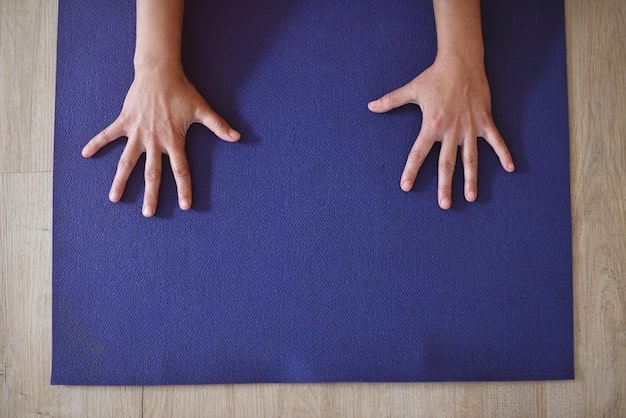Yoga for Weight Loss: Combine 3 Styles for Maximum Fat Burn

Yoga for weight loss can be significantly enhanced by combining different styles such as Vinyasa, Ashtanga, and Yin, which boost calorie burn and promote fat reduction through varied intensities and muscle engagement.
Looking to enhance your weight loss journey with yoga? Combining specific yoga styles can maximize calorie burn and fat reduction, offering a holistic approach to fitness and well-being. Yoga for weight loss doesn’t have to be a one-size-fits-all approach; let’s explore how to tailor your practice for optimal results.
Unlock Weight Loss with Yoga: Combining Styles for Better Results
Yoga has long been celebrated for its mental and physical health benefits, but can it truly contribute to weight loss? The answer is a resounding yes, especially when you strategically combine different styles to create a well-rounded workout.
By understanding how various yoga styles impact your body, you can curate a practice that aligns with your weight loss goals. Let’s dive into how combining Vinyasa, Ashtanga, and Yin yoga can be a game-changer for shedding pounds and toning up.
Vinyasa Yoga: The Calorie-Burning Dynamo
Vinyasa, often referred to as “flow yoga,” is characterized by its continuous sequence of poses synchronized with breath. This dynamic style not only builds strength and flexibility but also elevates your heart rate, making it an excellent choice for burning calories.
The flowing nature of Vinyasa keeps you moving, preventing your body from settling into a static state. Consistent movement translates to more calories burned, contributing to overall weight loss efforts.
Why Vinyasa for Weight Loss?
Vinyasa’s intensity can be adjusted to suit different fitness levels, making it accessible to beginners and challenging for experienced practitioners alike. Here’s why Vinyasa is a powerful tool for weight loss:
- Increased Heart Rate: The continuous flow elevates your heart rate, turning your yoga session into a cardiovascular workout.
- Muscle Engagement: Vinyasa requires constant muscle engagement, which helps build lean muscle mass and boosts metabolism.
- Enhanced Core Strength: Many Vinyasa sequences incorporate core-strengthening poses, contributing to a toned midsection.
In addition to physical benefits, Vinyasa helps reduce stress, a common culprit behind weight gain. By managing stress levels, you’re less likely to turn to emotional eating as a coping mechanism.
Ashtanga Yoga: Intensity and Discipline for Weight Management
Ashtanga yoga is a rigorous and structured style that follows a specific sequence of poses. Known for its intensity and emphasis on breath control (Ujjayi breathing), Ashtanga is a fantastic option for those seeking a challenging and effective weight loss workout.
The consistent sequence of Ashtanga builds internal heat, detoxifies the body, and promotes significant calorie burn. Its disciplined approach also fosters mental resilience and determination, qualities that support long-term weight management.

Benefits of Ashtanga for Weight Loss
Ashtanga’s structured sequence and demanding poses offer a range of benefits that contribute to weight loss and overall fitness:
- High Calorie Burn: The continuous and intense nature of Ashtanga results in a significant calorie expenditure.
- Improved Metabolism: Regular practice can boost your metabolic rate, helping your body burn more calories even at rest.
- Increased Strength and Stamina: The demanding poses build strength and endurance, making everyday activities easier and more enjoyable.
Ashtanga’s focus on discipline and breath control can also help you develop a greater awareness of your body and eating habits, aiding in making healthier choices both on and off the mat.
Yin Yoga: Strategic Recovery and Stress Reduction
While Vinyasa and Ashtanga focus on dynamic movement and muscle engagement, Yin yoga takes a different approach. Yin involves holding passive poses for extended periods, targeting the deep connective tissues (fascia) rather than the muscles.
At first glance, Yin yoga might not seem like an obvious choice for weight loss, but its benefits are crucial for a well-rounded and sustainable approach. Yin helps reduce stress, improve flexibility, and enhance overall well-being, all of which indirectly support weight management.
How Yin Supports Weight Loss
Yin yoga may not burn as many calories as Vinyasa or Ashtanga, but its indirect contributions to weight loss are significant:
- Stress Reduction: Yin’s calming effect helps lower cortisol levels, reducing stress-related cravings and emotional eating.
- Improved Flexibility: Enhanced flexibility allows you to perform other exercises with greater ease and range of motion.
- Better Sleep: Yin promotes relaxation and can improve sleep quality, which is essential for hormone regulation and weight management.
By incorporating Yin yoga into your routine, you create a balanced practice that supports both your physical and mental well-being, fostering a healthier relationship with food and your body.
Combining the Styles: A Sample Weekly Schedule
To maximize the benefits of these three yoga styles, it’s essential to create a balanced weekly schedule that incorporates each style effectively. Here’s a sample schedule to get you started:
Remember to listen to your body and adjust the schedule as needed. It’s always a good idea to consult with a yoga instructor or healthcare professional before starting any new exercise program.
A Balanced Yoga Schedule
A well-structured schedule ensures you reap the diverse benefits of each style without overtraining or neglecting any aspect of your well-being:
Here’s a suggested schedule for incorporating Vinyasa, Ashtanga, and Yin yoga into your weekly routine.
- Monday: Vinyasa (60 minutes) – Start the week with an energizing flow to boost metabolism.
- Tuesday: Yin (75 minutes) – Slow down and release tension with deep stretches.
- Wednesday: Rest or Light Activity – Allow your body to recover.

Consistency is key. Sticking to a regular schedule will yield the best results over time. Monitor your progress and make adjustments as needed, always prioritizing your body’s signals.
Nutritional Synergy: Complementing Yoga with a Healthy Diet
While yoga is an effective tool for weight loss, it’s essential to complement your practice with a healthy and balanced diet. Nutrition plays a pivotal role in achieving and maintaining your weight loss goals.
Focus on whole, unprocessed foods, including plenty of fruits, vegetables, lean proteins, and healthy fats. Avoid sugary drinks, processed snacks, and excessive amounts of saturated and unhealthy fats.
How to Fuel Your Yoga Practice
Proper nutrition not only supports weight loss but also enhances your yoga practice by providing the energy and nutrients your body needs to perform at its best:
- Hydration: Drink plenty of water throughout the day, especially before, during, and after your yoga sessions.
- Protein: Consume adequate protein to support muscle repair and growth.
- Balanced Meals: Opt for balanced meals that include a mix of carbohydrates, proteins, and fats to sustain energy levels.
By pairing your yoga practice with a mindful and nutritious diet, you’ll create a powerful synergy that supports both your physical and mental well-being.
Combining Vinyasa for calorie burning, Ashtanga for intensity and discipline, and Yin for stress reduction and flexibility creates a well-rounded approach to yoga for weight loss. Remember to listen to your body, stay consistent, and complement your practice with a healthy diet for optimal results.
| Key Point | Brief Description |
|---|---|
| 🔥 Vinyasa | Dynamic style boosts calorie burn and builds strength. |
| 💪 Ashtanga | Intense sequence enhances metabolism and stamina. |
| 🧘 Yin Yoga | Reduces stress, improves flexibility, and aids sleep. |
| 🍎 Nutrition | Balanced diet maximizes yoga’s weight loss benefits. |
Frequently Asked Questions (FAQ)
▼
Yes, when combined strategically, yoga can be effective for weight loss. Styles like Vinyasa and Ashtanga burn calories, while Yin helps reduce stress, supporting a holistic approach to weight management.
▼
Aim for at least three to five times a week, incorporating a mix of dynamic styles like Vinyasa and Ashtanga with calming practices such as Yin yoga for balanced results.
▼
Ashtanga can be intense for beginners. It’s advisable to start with a gentler Vinyasa class or a modified Ashtanga sequence to build strength and flexibility gradually.
▼
Yin yoga reduces stress and improves flexibility, addressing emotional eating and promoting better sleep, all indirectly supporting weight loss and a healthier lifestyle.
▼
Generally, you only need a yoga mat. However, blocks and straps can be helpful for beginners to modify poses and enhance their practice, especially in Yin and Ashtanga.
Conclusion
Incorporating a blend of Vinyasa, Ashtanga, and Yin yoga into your routine can significantly enhance your weight loss journey. By combining the calorie-burning benefits of dynamic styles with the stress-reducing effects of Yin, you’ll create a holistic approach to fitness that supports both your body and mind. Remember to complement your practice with a healthy diet and listen to your body, and you’ll be well on your way to achieving your weight loss goals.





